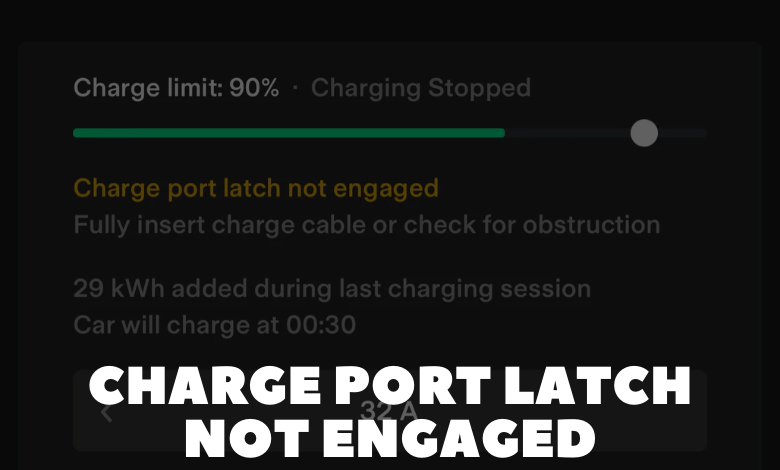Charge Port Latch Not Engaged

As a dedicated Tesla technician with years of hands-on experience, I’ve encountered a multitude of issues that Tesla owners face, ranging from the mundane to the perplexing. One such problem that occasionally surfaces is the frustration of a Tesla charge port latch not engaging properly. In this comprehensive guide, we’ll delve deep into the complexities of the charge port latch mechanism, explore the potential causes behind its failure to engage, and provide actionable troubleshooting steps to help you resolve this perplexing issue.
Understanding the Charge Port Latch Mechanism
Before diving into troubleshooting, it’s crucial to grasp the fundamentals of how the Tesla charge port latch operates. The charge port latch serves as a mechanism to securely lock the charging connector in place during charging sessions, ensuring a stable connection between the vehicle and the charging station. When functioning correctly, the latch engages automatically when the charging connector is inserted into the charge port and disengages upon completion of the charging process or when manually released via the vehicle’s touchscreen or key fob.
Potential Causes of Charge Port Latch Failure
- Mechanical Obstruction: One of the most common reasons for a charge port latch not engaging is the presence of debris, dirt, or foreign objects obstructing the latch mechanism. Even a small accumulation of dirt or debris can prevent the latch from fully engaging, resulting in difficulty inserting the charging connector or intermittent latch engagement.
- Faulty Latch Actuator: The charge port latch is actuated by an electric motor or solenoid controlled by the vehicle’s onboard electronics. A malfunctioning or defective latch actuator can lead to inconsistent latch engagement or complete failure to engage. This may be due to electrical issues, mechanical wear and tear, or component failure within the actuator assembly.
- Software Glitch: In some cases, a software glitch or malfunction in the vehicle’s onboard computer system may cause the charge port latch to malfunction. This could be triggered by software updates, system errors, or communication issues between the charge port module and the vehicle’s control unit.
- Physical Damage: Accidental impact or physical damage to the charge port area can result in misalignment or damage to the latch mechanism, hindering its ability to engage properly. Common sources of physical damage include collisions, improper handling of the charging connector, or environmental factors such as extreme weather conditions.
Troubleshooting Steps and Solutions
Now that we’ve identified potential causes, let’s explore troubleshooting steps and solutions to address a Tesla charge port latch not engaging:
- Inspect and Clean: Start by visually inspecting the charge port area for any signs of debris, dirt, or obstruction. Use compressed air or a soft brush to carefully clean the charge port and latch mechanism, ensuring that no foreign objects are impeding the latch’s movement.
- Reset Vehicle: Perform a soft reset of the vehicle’s onboard systems by pressing and holding the scroll wheels on the steering wheel until the touch screen goes blank and the Tesla logo reappears. This can help reset any software glitches or temporary errors that may be affecting the charge port latch.
- Check Charging Connector: Inspect the charging connector for any damage or signs of wear that may be preventing proper engagement with the charge port. Ensure that the connector is fully inserted into the charge port and attempt to engage the latch manually using the touchscreen or key fob.
- Diagnostic Scan: If the issue persists, consider performing a diagnostic scan using Tesla’s official diagnostic software or consult a certified technician for assistance. A diagnostic scan can identify any underlying electrical or mechanical issues affecting the charge port latch and provide detailed insights into potential solutions.
- Schedule Service Appointment: If all else fails, it may be necessary to schedule a service appointment with Tesla Service Center for further diagnosis and repair. Certified technicians have the expertise and resources to diagnose complex issues with the charge port latch and implement appropriate repairs or replacements as needed.
Ensuring Seamless Charging Experiences
In conclusion, a Tesla charge port latch not engaging can be a frustrating and inconvenient issue for Tesla owners, but with the right knowledge and troubleshooting steps, it can be effectively addressed. By understanding the mechanics of the charge port latch, identifying potential causes of failure, and following systematic troubleshooting procedures, you can restore seamless charging functionality to your Tesla vehicle and enjoy uninterrupted electric driving experiences.
Remember, if you encounter persistent issues or require professional assistance, don’t hesitate to reach out to Tesla’s dedicated support team or schedule a service appointment for prompt resolution.
